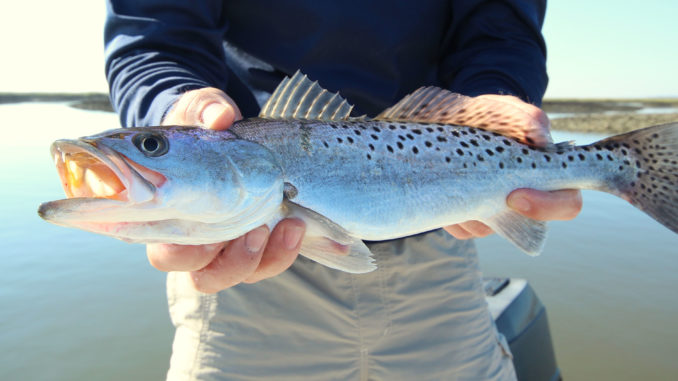
South Carolina specks have likely won this time
In recent years, South Carolina anglers have enjoyed some of the best speckled trout fishing ever, in terms of both numbers and size. A driving force was several mild winters since the last fish kill in January 2011, combined with behavioral changes in anglers.
The winter of 2014, however, has not been as mild, leaving many anglers and guides concerned.
“When fishing for reds is tough, seatrout can be a big day-saver, allowing me to put clients on a lot of fish consistently” said Capt. Owen Plair of Bay Street Outfitters in Beaufort.
Fortunately, a few very cold days does not automatically mean a fish kill will occur, because the water temperature does not drop anywhere near the same rate as the air temperature does, so it usually takes many days of well-below average temperatures to seriously affect trout stocks.
“Although there has been some cold weather recently, our inshore waters had above-average temperatures at the beginning of January, which helped buffer seatrout from the effects of cold snaps,” said Dr. Steve Arnott of the S.C. Department of Natural Resources’ Marine Division.
Trammel net surveys confirmed that trout survived cold snaps early in January, but the effects of later cold snaps will not be known until more-recent surveys are completed and available. When January gave way to February, the average water temperature in Charleston Harbor was in the mid-40s, and SCDNR research indicates that juvenile trout are in mortal danger when the temperature drops to between 36 and 39 degrees. The temperature when the second winter storm slammed into the Southeast in the waning days of January was still five degrees above those levels.
On the other hand, water in small creeks and tidal flats will fall well below temperatures recorded in the deeper water of the harbor, so isolated cold-stun kills may have happened in some of those areas where trout do not have nearby access to deeper, warmer water. Often, a picture of a dead trout or two in a tidal creek or on a flat will cause headlines of trout decimation on online message boards, but chances are this isn’t the case.
According to Arnott, cold water temperatures can affect trout mortality in a few ways. “Near their lower limit, a fish’s ability to maintain a chemical balance across its cell membrane slows, and this physiological imbalance can ultimately result in death,” he said.
But, even if the temperatures do not fall low enough to kill trout, they can still contribute to other life-ending factors.
“Cold may make the fish vulnerable to other sources of mortality, such as dolphin predation,” Arnott said. “Dolphins are warm-blooded and need a lot more food when it is cold, whereas fish become more sluggish and easier to catch. Sometimes, cold can make fish vulnerable to diseases because their immune system slows down.”
Cold can have an effect on redfish as well, but this is rare, because even colder temperatures are required.
“While seatrout numbers nearly always go down after a cold winter, red drum numbers sometimes go up” Arnott said.
Other species move offshore to deeper, warmer waters during the winter, so fish kills are limited to only those species that live in our estuaries year-round.
From what we know about cold weather, chances are that trout numbers will be affected to some degree, though likely not anywhere near the extent of the 2011 kill, which came off the heels of a cold kill in the winter of 2009-10. That said, it is worth noting that South Carolina’s great fishery is not just the result of a few mild winters; anglers have also played a big part and can continue to do so.
Catches of seatrout have increased in recent years as well as the number of anglers pursuing them, but the proportion of actual trout harvested has declined. Part of this is because of changes in size and creel limits, but also an increase in voluntary catch and release angling.
After the January 2011 cold-stun kills, anglers were asked to voluntarily stop harvesting seatrout through that year’s spawn to aid in recovery. Anglers complied, and that helped lay the foundation for a tremendous recovery. A continuation of catch-and-release by anglers will help ensure that a great trout fishery remains in the future, even after cold-stun kills. An important consideration for those who wish to support the fishery by employing catch-and-release is to do it correctly.
“Anglers can definitely help by doing everything possible to make sure released fish are in good shape,” Arnott said. “In other words, treat them gently, don’t overplay them and keep them out of the water for as short a time as possible.”
Of course, there is one sure fire way to gauge the current state of South Carolina’s seatrout fishery: go fish for them and find out firsthand. Fishing in 2013 was some of the best in years, and chances are anglers who target trout this year will not be disappointed.



Be the first to comment